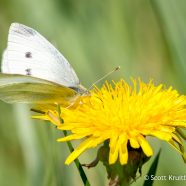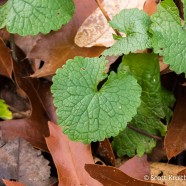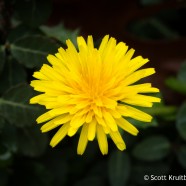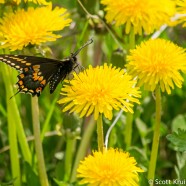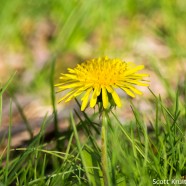Cabbage White
The Cabbage White (Pieris rapae) is a non-native “pest” butterfly species, and here you can see it is feeding on a Dandelion (Taraxacum officinale), a non-native weed…but you know what, the ship has sailed on trying to solve that problem. I realize that is easy for me to say because I am not employed in agriculture. However, we are not going to wake up tomorrow and eliminate these species from North America. Even if we were to try it would be terribly harmful, and in the case of the dandelion we would be pumping even more toxic chemicals into our environment – as...
Read MoreGarlic Mustard
You can usually spot invasive plants in the spring by seeing what is greening up and flowering first, especially in warmer than usual seasons. The continuing high temperatures have a lot of non-native and/or invasive plant life springing up despite the fact it is winter, and Garlic Mustard (Alliaria petiolata) has been one that I noticed plenty of right now. It has been downright creepy to see so much green all over the ground, from the grass to species like this one conquering the leaf litter that has yet to decay. In certain locations in Connecticut, where there has not been a hard freeze...
Read MoreChristmas Dandelion
I photographed this lovely little dandelion blooming yesterday…yes, this is a Christmas dandelion. It was in Connecticut, the state that is a part of New England, on December 25. These temperatures may be enjoyable for some of us, but such a shift is not helping our plant or animal life. They need a prolonged, uninterrupted dormant period, and starting to “go” now only to be put back in more eventual cold and snow for a couple months may harm them later. We are likely to stay above-average for temperatures, but it will nevertheless cool off to something more seasonable. The...
Read MoreBlack Swallowtail
After a long, cold and snowy winter it has taken a bit of time for the first Lepidoptera to start to emerge, but we are off! We will definitely be showing you more of the butterflies and moths we spot over the next several months. Here we have the Black Swallowtail (Papilio polyxenes) enjoying those “weeds”, also known as early season sources of nectar and pollen for our insects. Scott Kruitbosch Conservation & Outreach Coordinator
Read MoreDandy Dandelions
Come on, what’s wrong with the dandelion anyway? We call it a “weed” but it’s a pretty, tiny yellow flower. What could be so distasteful about that? These flowers end up as important early season nectaring and pollen plants for bees, a place for lepidoptera larvae to grow and feed, and our birds eat it. You can even eat this nutritious plant, too! Every bit. Not that you may want to unless you know what has been going in and on your lawn… Scott Kruitbosch Conservation & Outreach Coordinator
Read More



